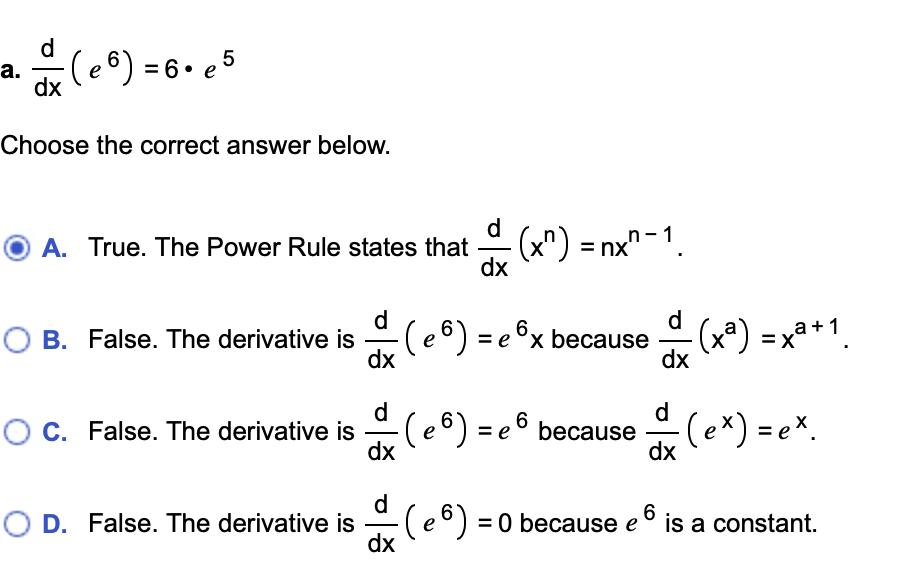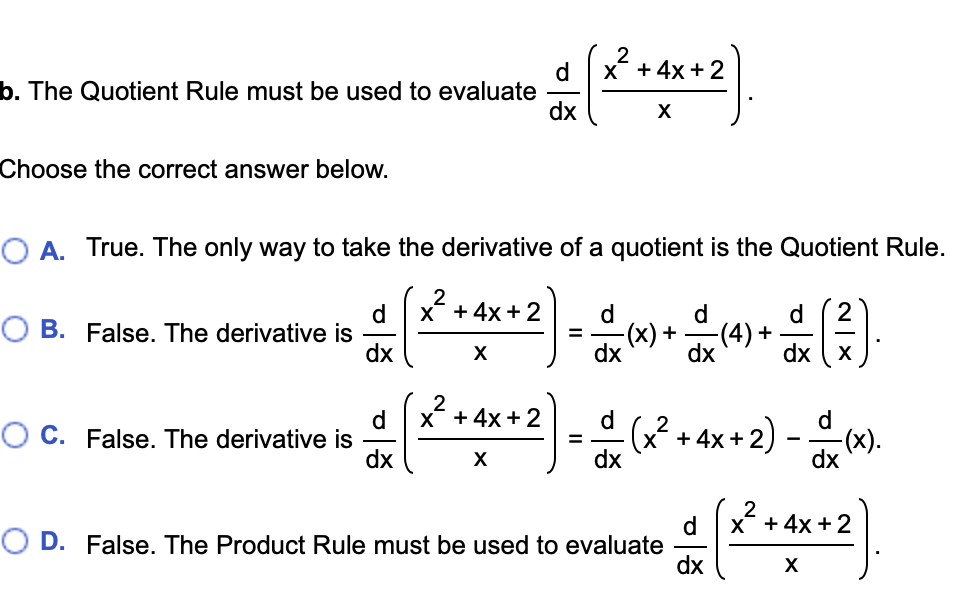d (e6) = 6• e5 dx Choose the correct answer below. d (x^) = nx"-1, dx O A. True. The Power Rule states that d d (e) = e 6x because - (x) = xa* 1. dx D B. False. The derivative is dx d O C. False. The derivative is dx d (e©) = e® because (e*) = e*. dx 6. O D. False. The derivative is dx = 0 because e° is a constant.
d (e6) = 6• e5 dx Choose the correct answer below. d (x^) = nx"-1, dx O A. True. The Power Rule states that d d (e) = e 6x because - (x) = xa* 1. dx D B. False. The derivative is dx d O C. False. The derivative is dx d (e©) = e® because (e*) = e*. dx 6. O D. False. The derivative is dx = 0 because e° is a constant.
Calculus: Early Transcendentals
8th Edition
ISBN:9781285741550
Author:James Stewart
Publisher:James Stewart
Chapter1: Functions And Models
Section: Chapter Questions
Problem 1RCC: (a) What is a function? What are its domain and range? (b) What is the graph of a function? (c) How...
Related questions
Question

Transcribed Image Text:d
dx (e8) = 6. e5
а.
Choose the correct answer below.
A. True. The Power Rule states that (x") = nx"-1
dx
d
O B. False. The derivative is
dx
d
-(e®) = e ©x because
(x*) =xa*1.
dx
= X
d
O C. False. The derivative is
dx
d
e©) = e © because (ex) = e*.
dx
d
O D. False. The derivative is
(e®)=
dx
6
= 0 because e
is a constant.

Transcribed Image Text:X + 4x + 2
b. The Quotient Rule must be used to evaluate
dx
X
Choose the correct answer below.
O A. True. The only way to take the derivative of a quotient is the Quotient Rule.
2
X + 4x + 2
d
O B. False. The derivative is
dx
d.
d.
d
(x) +
-(4) +
X
dx
dx
dx
X + 4x +2
d
O C. False. The derivative is
dx
d
d
(x² + 4x + 2)
-(x).
dx
X
dx
X +4x + 2
d
O D. False. The Product Rule must be used to evaluate
dx
X
Expert Solution
This question has been solved!
Explore an expertly crafted, step-by-step solution for a thorough understanding of key concepts.
Step by step
Solved in 2 steps with 1 images

Recommended textbooks for you

Calculus: Early Transcendentals
Calculus
ISBN:
9781285741550
Author:
James Stewart
Publisher:
Cengage Learning

Thomas' Calculus (14th Edition)
Calculus
ISBN:
9780134438986
Author:
Joel R. Hass, Christopher E. Heil, Maurice D. Weir
Publisher:
PEARSON

Calculus: Early Transcendentals (3rd Edition)
Calculus
ISBN:
9780134763644
Author:
William L. Briggs, Lyle Cochran, Bernard Gillett, Eric Schulz
Publisher:
PEARSON

Calculus: Early Transcendentals
Calculus
ISBN:
9781285741550
Author:
James Stewart
Publisher:
Cengage Learning

Thomas' Calculus (14th Edition)
Calculus
ISBN:
9780134438986
Author:
Joel R. Hass, Christopher E. Heil, Maurice D. Weir
Publisher:
PEARSON

Calculus: Early Transcendentals (3rd Edition)
Calculus
ISBN:
9780134763644
Author:
William L. Briggs, Lyle Cochran, Bernard Gillett, Eric Schulz
Publisher:
PEARSON

Calculus: Early Transcendentals
Calculus
ISBN:
9781319050740
Author:
Jon Rogawski, Colin Adams, Robert Franzosa
Publisher:
W. H. Freeman


Calculus: Early Transcendental Functions
Calculus
ISBN:
9781337552516
Author:
Ron Larson, Bruce H. Edwards
Publisher:
Cengage Learning